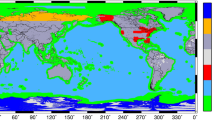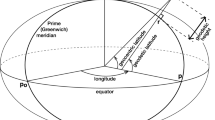Abstract
This paper presents a new remote sensing (RS) algorithm for retrieving instantaneous sea surface solar irradiance (SR) by using the XGBoost (XGB) package in RStudio and available remote sensing data along with ground-truth solar irradiance data. By means of XGB, the new RS algorithm, called LSU model, was structurally built with nine key RS parameters, including photosynthetically available radiation (PAR); instantaneous PAR (iPAR); water leaving reflectance Rrs at wavelengths 412, 443, 469, and 488 nm; angstrom; aerosol optical thickness (aot_869); and latitude that represent major sources and sinks of solar irradiance, as model input variables. Among the nine parameters, the most important four parameters are PAR, iPAR, latitude, and aot_869. It was found that the sea surface SR is highly affected by conditions in both the atmosphere and the seawater. The aot_869 is by far the most important factor describing the effects of the atmospheric absorption and scattering of SR before reaching the sea surface. The most important factors describing the effects of seawater characteristics on solar irradiance are PAR, iPAR, and latitude. Comparisons with existing SR models indicate that LSU model is scientifically sound due to the use of major source and sink factors of SR as model input variables. LSU model is also technically accurate due to its fine resolution (1×1 km) and overall best performance in predicting instantaneous SR. More importantly, LSU model is globally applicable as it can be utilized to obtain global-scale SR data for any day, any time, and anywhere in the world.






Similar content being viewed by others
Data availability
Data and model codes will be available upon request.
References
Ahmad, M. J., & Tiwari, G. N. (2011). Solar radiation models – A review. International Journal of Energy Research, 35(4), 271–290. https://doi.org/10.1002/er.1690
Ahmad, M. W., Mourshed, M., & Rezgui, Y. (2018). Tree-based ensemble methods for predicting PV power generation and their comparison with support vector regression. Energy, 164, 465–474. https://doi.org/10.1016/j.energy.2018.08.207
America Society of Heating, Refrigeration, and Air-conditioning Engineers. (1999). ASHRAE applications handbook (SI). ASHRAE, Atlanta.
Anjali, M., Dubey, M. S., & Dixit, M. M. (2018). A survey of XGBoost system. International Journal of advance Technology & Engineering Research (IJATER), 8(3), 25–30.
Bakirci, K. (2009). Models of solar radiation with hours of bright sunshine: A review. Renewable and Sustainable Energy Reviews, 13(9), 2580–2588. https://doi.org/10.1016/j.rser.2009.07.011
Benali, L., Notton, G., Fouilloy, A., Voyant, C., & Dizene, R. (2019). Solar radiation forecasting using artificial neural network and random forest methods: Application to normal beam, horizontal diffuse and global components. Renewable Energy, 132, 871–884. https://doi.org/10.1016/j.renene.2018.08.044
Breiman, L., Friedman, J., Olshen, R., & Stone, C. (1984). Classification and regression trees. crc press.
Chen, M., Zhuang, Q., & He, Y. (2014). An efficient method of estimating downward solar radiation based on the MODIS observations for the use of land surface modeling. Remote Sensing, 6(8), 7136–7157. https://doi.org/10.3390/rs6087136
Chen, T., & Guestrin, C. (2016). XGBoost: A scalable tree boosting system. Association for Computing Machinery, 785–794. https://doi.org/10.1145/2939672.2939785
Cotorcea, A., & Visa, I. (2017). A review of methods for solar radiation estimation used in off-shore applications. Scientific Bulletin “Mircea cel Batran” Naval Academy, 20(2), 8–11. https://doi.org/10.21279/1454-864X-17-I2-002
Escobedo, J. F., Gomes, E. N., Oliveira, A. P., & Soares, J. (2011). Ratios of UV, PAR and NIR components to global solar radiation measured at Botucatu site in Brazil. Renewable Energy, 36(1), 169–178. https://doi.org/10.1016/j.renene.2010.06.018
Fan, J., Wang, X., Wu, L., Zhou, H., Zhang, F., Yu, X., Lu, X., & Xiang, Y. (2018). Comparison of Support Vector Machine and Extreme Gradient Boosting for predicting daily global solar radiation using temperature and precipitation in humid subtropical climates: A case study in China. Energy Conversion and Management, 164, 102–111. https://doi.org/10.1016/j.enconman.2018.02.087
Friedman, J. H. (2002). Stochastic gradient boosting. Computational Statistics & Data Analysis, 38(4), 367–378. https://doi.org/10.1016/S0167-9473(01)00065-2
Gautier, C., Diak, G., & Masse, S. (1980). A simple physical model to estimate incident solar radiation at the surface from GOES satellite data. Journal of Applied Meteorology and Climatology, 19(8), 1005–1012. https://doi.org/10.1175/1520-0450(1980)019<1005:aspmte>2.0.co;2
Ghimire, S., Deo, R. C., Raj, N., & Mi, J. (2019). Deep learning neural networks trained with MODIS satellite-derived predictors for long-term global solar radiation prediction. Energies, 12(12), 2407. https://doi.org/10.3390/en12122407
Haar, T.H.V., Ellis, J.S., 1978. Determination of the solar energy microclimate of the United States using satellite data.
Huang, L., Kang, J., Wan, M., Fang, L., Zhang, C., & Zeng, Z. (2021). Solar radiation prediction using different machine learning algorithms and implications for extreme climate events. Frontiers in Earth Science, 9. https://doi.org/10.3389/feart.2021.596860
Jia, D., Yang, L., Gao, X., & Li, K. (2023). Assessment of a new solar radiation nowcasting method based on FY-4A Satellite Imagery, the McClear Model and SHapley Additive exPlanations (SHAP). Remote Sensing, 15(9), 2245. https://doi.org/10.3390/rs15092245
Jiménez-Muñoz, J. C., Sobrino, J. A., & Mattar, C. (2012). Recent trends in solar exergy and net radiation at global scale. Ecological Modelling, 228, 59–65. https://doi.org/10.1016/j.ecolmodel.2011.12.027
Karabashev, G. S. (2021). Spectral indexation of pixels of MODIS sea surface images for detecting inconstancy of phytopigment composition in water. Oceanologia, 63, 482–496. https://doi.org/10.1016/j.oceano.2021.06.001
Kimball, H. H. (1928). Amount of solar radiation that reaches the surface of the earth on the land and on the sea, and methods by which it is measured. Monthly Weather Review, 56(10), 393–398.
Kumar, R., Aggarwal, R. K., & Sharma, J. D. (2015). Comparison of regression and artificial neural network models for estimation of global solar radiation. Renewable and Sustainable Energy Reviews, 52, 1294–1299. https://doi.org/10.1016/j.rser.2015.08.021
Laevastu, T. (1960). Factors affecting the temperature of the surface layer of the sea. Comments on Physical Mathematics, 25, 1–136.
Lee, Z., Hu, C., Shang, S., Du, K., Lewis, M., Arnone, R., & Brewin, R. (2013). Penetration of UV-visible solar radiation in the global oceans: Insights from ocean color remote sensing. Journal of Geography Research: Oceans, 118(9), 4241–4255. https://doi.org/10.1002/jgrc.20308
Li, M., Tang, X., Wu, W., & Liu, H. (2013). General models for estimating daily global solar radiation for different solar radiation zones in mainland China. Energy Conversion and Management, 70, 139–148. https://doi.org/10.1016/j.enconman.2013.03.004
Linares-Rodriguez, A., Ruiz-Arias, J. A., Pozo-Vazquez, D., & Tovar-Pescador, J. (2013). An artificial neural network ensemble model for estimating global solar radiation from Meteosat satellite images. Energy, 61, 636–645. https://doi.org/10.1016/j.energy.2013.09.008
Lopez, G., & Batlles, F. J. (2014). Estimating Solar radiation from MODIS data. Energy Procedia, 49, 2362–2369. https://doi.org/10.1016/j.egypro.2014.03.250
Lundberg, S. M., Erion, G. G., Lee, S.-I., 2018. Consistent individualized feature attribution for tree ensembles. arXiv preprint arXiv:1802.03888. 10.48550/arXiv.1802.03888
Myhre, G., Myhre, C. E. L., Samset, B. H., & Storelvmo, T. (2013). Aerosols and their relation to global climate and climate sensitivity. Nature Education Knowledge, 4(5), 7.
Paulson, C. A., & Simpson, J. J. (1977). Irradiance measurements in the upper ocean. Journal of Physical Oceanography, 7(6), 952–956. https://doi.org/10.1175/1520-0485(1977)007<0952:IMITUO>2.0.CO;2
Piri, J., & Kisi, O. (2015). Modelling solar radiation reached to the Earth using ANFIS, NN-ARX, and empirical models (case studies: Zahedan and Bojnurd stations). Journal of Atmospheric and Solar-Terrestrial Physics, 123, 39–47. https://doi.org/10.1016/j.jastp.2014.12.006
Qazi, A., Fayaz, H., Wadi, A., Raj, R. G., Rahim, N. A., & Khan, W. A. (2015). The artificial neural network for solar radiation prediction and designing solar systems: A systematic literature review. Journal of Cleaner Production, 104, 1–12. https://doi.org/10.1016/j.jclepro.2015.04.041
Reed, R. K. (1976). An evaluation of cloud factors for estimating insolation over the ocean (Vol. 8). Pacific Marine Environmental Laboratory, Environmental Research Laboratories.
Serrano, D., Marín, M. J., Utrillas, M. P., Tena, F., & Martinez-Lozano, J. A. (2010). Measurement and modelling of global erythemal irradiance on inclined planes. Tethys, 7, 57–66.
Tabata, S. (1964). Insolation in relation to cloud amount and sun’s altitude. Studies on Oceanography, 202–210.
Tang, W., Yang, K., Qin, J., Li, J., & Ye, J. (2021). How accurate are satellite-derived surface solar radiation products over tropical oceans? Journal of Atmospheric and Oceanic Technology, 38(2), 283–291. https://doi.org/10.1175/JTECH-D-20-0099.1
Urraca, R., Huld, T., Gracia-Amillo, A., Martinez-de-Pison, F. J., Kaspar, F., & Sanz-Garcia, A. (2018). Evaluation of global horizontal irradiance estimates from ERA5 and COSMO-REA6 reanalyses using ground and satellite-based data. Solar Energy, 164, 339–354. https://doi.org/10.1016/j.solener.2018.02.059
Wong, L. T., & Chow, W. K. (2001). Solar radiation model. Applied Energy, 69(3), 191–224. https://doi.org/10.1016/S0306-2619(01)00012-5
Yadav, A. K., & Chandel, S. S. (2014). Solar radiation prediction using artificial neural network techniques: A review. Renewable and Sustainable Energy Reviews, 33, 772–781. https://doi.org/10.1016/j.rser.2013.08.055
Yeom, J. M., Park, S., Chae, T., Kim, J. Y., & Lee, C. S. (2019). Spatial assessment of solar radiation by machine learning and deep neural network models using data provided by the COMS MI geostationary satellite: A case study in South Korea. Sensors, 19(9), 2082. https://doi.org/10.3390/s19092082
Zapadka, T., Ostrowska, M., Stoltmann, D., & Krężel, A. (2020). A satellite system for monitoring the radiation budget at the Baltic Sea surface. Remote Sensing of Environment, 240, 111683. https://doi.org/10.1016/j.rse.2020.111683
Zhang, J., Zhao, L., Deng, S., Xu, W., & Zhang, Y. (2017). A critical review of the models used to estimate solar radiation. Renewable and Sustainable Energy Reviews, 70, 314–329. https://doi.org/10.1016/j.rser.2016.11.124
Zhang, Z., Deng, Z., Rusch, K. A., & Walker, N. D. (2015). Modeling system for predicting enterococci levels at Holly Beach. Marine Environmental Research, 109, 140–147. https://doi.org/10.1016/j.marenvres.2015.07.003
Funding
This work was part of a research project led by Zhiqiang Deng and supported by the US NASA (National Aeronautics and Space Administration: award number 80NSSC20M0216) and the Louisiana Board of Regents (LEQSF(2020-23)-Phase3-14).
Author information
Authors and Affiliations
Contributions
SA performed data collection, model development and validation, first draft writing, and graph construction under the direction of ZD who designed the methodology, edited the current version of the manuscript, and applied for funding. All authors read and approved the final manuscript.
Corresponding author
Ethics declarations
Competing interests
The authors declare no competing interests.
Additional information
Publisher’s Note
Springer Nature remains neutral with regard to jurisdictional claims in published maps and institutional affiliations.
Supplementary information
ESM 1
(DOCX 4770 kb)
Rights and permissions
Springer Nature or its licensor (e.g. a society or other partner) holds exclusive rights to this article under a publishing agreement with the author(s) or other rightsholder(s); author self-archiving of the accepted manuscript version of this article is solely governed by the terms of such publishing agreement and applicable law.
About this article
Cite this article
Aradpour, S., Deng, Z. Remote sensing algorithm for retrieving global-scale sea surface solar irradiance. Environ Monit Assess 195, 1355 (2023). https://doi.org/10.1007/s10661-023-11974-4
Received:
Accepted:
Published:
DOI: https://doi.org/10.1007/s10661-023-11974-4




